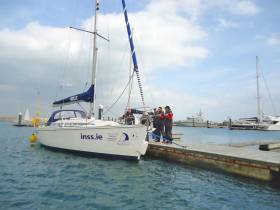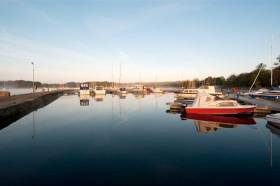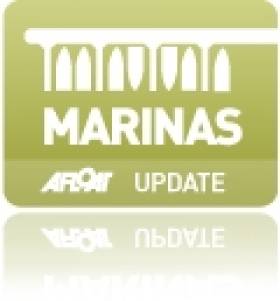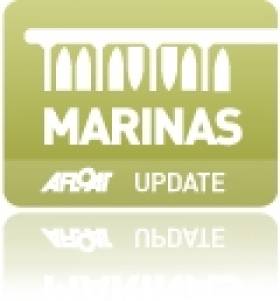Displaying items by tag: Mooring
Product Warning Over Mooring Ropes (UPDATED)
The Department of Transport, Tourism & Sport has issued a product warning for potential risk with the use of a mooring rope of non-European origin.
The rope, under the Marina Maxi brand of Axiom Cordages based in Mumbai, India, does not comply with relevant European standards as it could come apart during usage, and the parted rope could hit someone on board, causing injury or even death.
The affected product is a 12-strand mooring rope: UV stabilized high grade, synthetic compound with polyester and polypropylene, white colour (6ft canvas, covered and FIV tucks with compliance to OCIMF standards, eyes spliced at both ends).
This is not to be confused with a now-recalled product warning for a 24-strand mooring rope, comprising 50% polyester and 50% polysteel with a 52mm diameter, a breaking load of 60 tons and a length of 220 metres, without permanent marking. A marine casualty investigation report from Greek authorities clears up confusion over the rope's origins.
Owners and users of Marina Maxi ropes detailed herein should be advised of the risks and take appropriate action.
[This post was updated on 27 February 2020 to reflect an update to European Union records as to the affected mooring rope.]
[This post was updated on 4 March 2020 to include a link to the HBMIC report into an incident involving the affected mooring rope.]
[This post was updated on 5 March 2020 to correct the country of origin and manufacturer of the affected mooring rope.]
Day Course On Mooring & Handling Yachts Under Power
#HowToSail - A new series of short yachting courses at the Irish National Sailing & Powerboat School (INSS) begins with a one-day course on various techniques for mooring and handling a yacht under power.
This day-long course (9.30am-5pm) will run three times over the summer, with the first on Sunday 7 May, and covers the following topics:
- Basic engine checks
- Throttle and gear controls
- Rudder, propellers, propwalk and pivot points
- Going ahead and astern
- Use of wind and stream to aid manoeuvres
- Manoeuvring in confined spaces
- Moving to and from a marina berth under power
- Use of springs and other berthing techniques
The €99 course is recommended for any sailors heading abroad over the summer months who want to brush up on moving about tighter spaces, or those thinking about doing an ICC assessment.
#InlandWaters - With the end of the winter mooring period yesterday (Friday 31 March), Waterways Ireland reminds boaters on the Shannon Navigation, including the Shannon-Erne Waterway, that the five-day rule now applies at all public moorings.
Boats users may remain in one location for up to five days and then must leave that public mooring to allow for other boat users to arrive and enjoy the amenities throughout the River Shannon.
Lough Derg Floating Moorings at Mountshannon Harbour Reopen
Waterways Ireland say that floating moorings in Mountshannon Harbour on Lough Derg which had been closed to the public due to damage as a result of winter floods have now been reopened.
Shannon Navigation Winter Mooring Period Ends
Waterways Ireland reminds masters and owners of vessels that the winter mooring period finishes on the Shannon Navigation which includes the Shannon–Erne Waterway on Thurs 31 March.
Can Ireland Do Better With Visitor Moorings?
#HaveYourSay - With Ireland making a big push for this country's marinas at the London Boat Show this week, Afloat.ie reader Conan Breslin came to us with the following question about mooring for visiting boats in Ireland:
There seems to be no way of getting a mooring certified in Ireland. I own a 40ft Colin Archer yacht in Co Donegal and have often considered the possibility of leaving her on a swinging mooring. However every time I approach the subject with my UK insurer, the question of certification comes up.
Is there an authority which is available in this country that would be in a position to do this? The requirement is for shackles/rope or chain and the anchor to be inspected and signed off on for the season. Could this be addressed so that the visitor mooring system could be more widely used? The use of visitor mooring is not only beneficial to the visiting yachtsman but also less damaging to the seabed.
Secondly, living in the North West of Ireland it is plainly seen that the lack of infrastructure in our many harbours and almost zero marina facilities for the length of our coastline is not a great selling point. Visitors want to be able to leave a yacht and not have to deal with very often begrudging and uncaring commercial users.
Gweedore has the potential for a large marina although the development of such would require some major investment. However it would provide a 50nm stop between Lough Swilly and Killybegs (due to have a marina some time in the near future, I believe). So how does one go about making a proposal to see if it's a feasible option for investment?
What do you think of Conan's queries and suggestions? Let us know in the comments below!
Three Sisters Marina at New Ross in County Wexford is on the River Barrow and it is New Ross Town Council facility. It is nine miles up river from the confluence of the Suir and Barrow and it is 18 nautical miles from the sea at Hook Head.
The marina is a modern 66 berth facility. The marina has electrical shore power, mains water toilets and shower facilities. Alongside the marina is a major lift-out facility catering for vessels up to 50 tonnes.
The Marina Manager: John Dimond. The Email: [email protected]
Phone: 086 3889652 or 051 421284
Sligo Harbour Pontoon. Berthing for Yachts & Boats in Sligo
The pontoon jetty at Ballast Quay in Sligo is designed to be used primarily for day trips or shortterm stays in the City. The facility is made available for use by owners and authorised crew of leisure craft owned, managed and operated by Sligo County Council (SCC).
The pontoon is available to all local and visiting leisure craft and also available for long-term berthing either with or without crew.
The pontoon will also be available on a limited basis to sailing clubs wishing to host events during the sailing season.
Access to the Jetty area and to the pontoon is controlled by security coded locks, which (in the interests of security) are changed on a regular basis.
A pdf download of the Sligo County Council rules for the jetty is downloadable as a pdf document below

The boating pontoon at Ballast Quay in Sligo. Photo: WM Nixon
Arthurstown Pier Pontoon. Boat Berths in County Wexford
Arthurstown Pier is at Waterford Harbour’s eastern shore, seven miles north of Hook Head lighthouse. It is directly east of Passage East. The small quay has a stone bottom. In 2010, following the provision of €56,250 to improve boat access on piers along the Hook Peninsula such as Ballyhack, Slade and Arthurstown Wexford County Council installed a small pontoon facility to encourage leisure boating in the area. As well as local boaters the faciility is also proving popular with local fishermen.
Portmagee Harbour Pontoon. Boat Berths in Kerry
After first hatching its harbour plan over five years ago, National Tourism Award winning village Portmagee in County Kerry now looks certain to see a new pontoon finally installed at Portmagee pier in 2013. It will be a further boost for a Kerry already popular with visiting yachts and boats.
The idea is to link the network of facilities that terminate in West Cork with new facilities in County Kerry and Portmagee will be an important link in this process.
The plans are that both local Skellig Rock tourism boat operators and up to 20 visiting yachts at any one time can use the new village pontoon once it is installed.
The facility is being developed through a local community initiative with funding from Kerry County Council and Failte Ireland.
































































